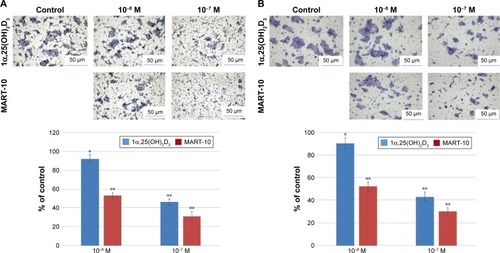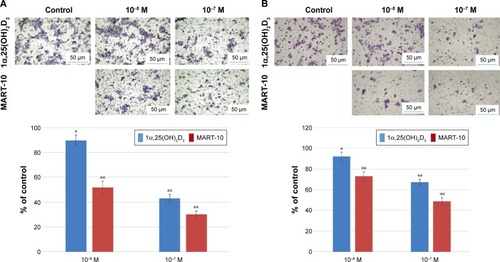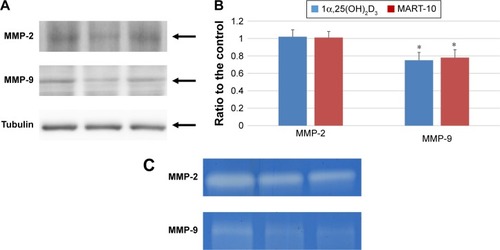Abstract
Even with multidisciplinary treatment, the prognosis and quality of life of patients diagnosed with head and neck squamous cell carcinoma (HNSCC) are still not satisfactory. Previously, 19-Nor-2α-(3-hydroxypropyl)-1α,25(OH)2D3 (MART-10), the new brand 1α,25(OH)2D3 analog, has been demonstrated to be an effective drug to inhibit HNSCC growth in vitro. Since most cancer patients die of metastasis, in this study, the antimetastatic effect of MART-10 on HNSCC was investigated. Our results reveal that both 1α,25(OH)2D3 and MART-10 effectively repressed the migration and invasion of HNSCC cells, with MART-10 being much more potent than 1α,25(OH)2D3. The antimetastatic effect of 1α,25(OH)2D3 and MART-10 was mediated by attenuation of epithelial–mesenchymal transition (EMT), which was supported by the finding that the expression of EMT-inducing transcriptional factors, Sail and Twist, was inhibited by 1α,25(OH)2D3 and MART-10. The upregulation of E-cadherin and downregulation of N-cadherin in FaDu cells induced by both drugs further confirmed the repression of EMT. In addition, 1α,25(OH)2D3 and MART-10 treatment inhibited intracellular MMP-9 expression and extracellular MMP activity in FaDu cells. Collectively, our results suggest that the less-calcemia 1α,25(OH)2D3 analog, MART-10, is a promising drug for HNSCC treatment. Further clinical studies are warranted.
Introduction
Head and neck squamous cell carcinoma (HNSCC), with 500,000 newly diagnosed cases yearly,Citation1 is a challenge for clinicians since radical surgery is the cornerstone treatment for HNSCC; however, the complex anatomy of the head and neck complicates surgical treatment. Traditional radiotherapy may sometimes be applied in HNSCC patients, but this kind of treatment may further worsen their quality of life. Even with multidisciplinary treatment, most HNSCC patients finally die of cancer metastasis. Currently, survival rates of 61% and 50% are observed for HNSCC patients at 5 years and 10 years, respectively.Citation2 Thus, development of a new regimen to prevent HNSCC metastasis should be prioritized to improve the survival.
Since the hormone-like role of vitamin D has been discovered, a variety of non-mineral functions of vitamin D have been demonstrated. 1α,25(OH)2D3, the active form of vitamin D, has been widely studied in anticancer research category due to the prodifferentiation, proapoptosis, antiangiogenesis, and antiproliferation effects of 1α,25(OH)2D3 noted in the past decades.Citation3,Citation4 To exert its hormone-like functions, 1α,25(OH)2D3 needs to bind with vitamin D receptor (VDR), which has been shown to exist in a variety of tissues in humans, indicating that 1α,25(OH)2D3 is able to affect almost all human tissues. However, hypercalcemia, which is induced by high dose of 1α,25(OH)2D3, impedes the clinical application of vitamin D for cancer treatment. For this reason, numerous vitamin D analogs have been synthesized with the aim to minimize hypercalcemia-inducing characteristics and to maximize the anticancer effect. 1α,25(OH)2D3 has been shown to be able to repress HNSCC cell growth, mainly through cell cycle arrest in G0/G1 phase.Citation5,Citation6 EB1089, a kind of 1α,25(OH)2D3 analog, was demonstrated to inhibit HNSCC cell growth in vitro and in vivo.Citation7 However, limited studies are available regarding the application of 1α,25(OH)2D3 and its analogs in HNSCC metastasis.
19-Nor-2α-(3-hydroxypropyl)-1α,25(OH)2D3 (MART-10) is a newly synthesized vitamin D analog,Citation8 which has been proved to have three times VDR-binding affinity than 1α,25(OH)2D3Citation9,Citation10 and much more resistance to CYP24A-mediated degradation,Citation11 suggesting that MART-10 is a potential vitamin D analog for cancer treatment. So far, our group has demonstrated that MART-10 exerts more potent anticancer growth effect than 1α,25(OH)2D3 in a number of cancersCitation12–Citation14 and is active in vivo without inducing hypercalcemia.Citation15 MART-10 has further been demonstrated to attenuate the metastatic potential of anaplastic thyroid cancer, breast cancer, and pancreatic cancer.Citation16–Citation18 We have previously shown that MART-10 could effectively repress cancer cell growth in HNSCC.Citation19 Since metastasis is the main cause of poor prognosis of HNSCC, in this study, we aimed to investigate the effect of MART-10 on HNSCC metastatic potential to further justify the clinical application of MART-10 for HNSCC treatment.
Materials and methods
Vitamin D compounds
1α,25(OH)2D3 was purchased from Sigma-Aldrich (St Louis, MO, USA). MART-10 was synthesized according to Kittaka et alCitation8 as described previously.
Cell culture
FaDu and SCC-25 cells, human SCC cell lines, were purchased from Bioresource Collection and Research Center (Taoyuan, Taiwan). Cells were grown in accordance with the guidance. Culture medium was changed three times per week. The authors advise that in Taiwan, no institutional review board approval is needed for cell culture studies.
Trans-well filter migration assay
FaDu or SCC-25 cells were pretreated for 2 days with indicated concentrations of either MART-10 or 1α,25(OH)2D3. Cells were then seeded on each trans-well filter with 8.0-µm pores (CoStar, Cambridge, MA, USA). The detailed procedure was as previously described.Citation16 Migrating cells were stained with Liu’s stain and washed with 1× PBS twice and counted under four random high-power microscopic fields (100×) per filter. The experiments were performed in triplicates.
Matrigel invasion assay
FaDu or SCC-25 cells were pretreated with indicated concentrations of 1α,25(OH)2D3 or MART-10. The assay was performed as previously described.Citation16 The invading cells were fixed by 4% paraformaldehyde (0.4% NaOH, 4% paraformaldehyde, and 3.8% hydrated sodium borate, pH 9.5). The invading cells were digitally photographed and counted under the microscope (IX71; Olympus Corporation, Tokyo, Japan). Experiments were performed in triplicates and repeated at least three times.
Gelatin zymography
After 2 days of indicated 1α,25(OH)2D3 or MART-10 treatment, the conditioned media were run under nonreducing conditions in 10% sodium dodecyl sulfate-polyacrylamide gels containing 2 mg/mL gelatin (Chemicon International Inc., Temecula, CA, USA). The detailed procedures were as described previously.Citation16
Western blot
The detailed procedures for Western blot were described previously.Citation16 The antibodies used in this experiment were monoclonal antibodies against E-cadherin (1:1,000, #3195; Cell Signaling Technology, Irvine, CA, USA), N-cadherin (1:1,000, #13116; Cell Signaling Technology), Snail (1:1,000, #3879; Cell Signaling Technology), Slug (1:1,000, #9585; Cell Signaling Technology), Twist (1:400, ab49254; Abcam, Cambridge, UK), MMP-2 (1:1,000, #13132; Cell Signaling Technology), and MMP-9 (1:1,000, #13667; Cell Signaling Technology). The blots were detected with enhanced chemiluminescence reagents (WBKLS0500; EMD Millipore, Billerica, MA, USA). Membranes were detected with VersaDoc™ Imaging System (Bio-Rad Laboratories Inc., Hercules, CA, USA).
Statistics method
The data from each group were compared by Student’s t-test. P-value <0.05 was considered as a significant difference. The program of Excel 2010 was used to perform the statistics.
Result
Evaluation of 1α,25(OH)2D3 and MART-10 effects on HNSCC cell metastasis
To investigate the effects of 1α,25(OH)2D3 and MART-10 on the metastatic potential of HNSCC cells, invasion and migration assays were conducted. As shown in , 10−8 M or 10−7 M 1α,25(OH)2D3 repressed FaDu cell migration to 92%±4% or 46%±3% of the control. MART-10, at 10−8 M and 10−7 M, decreased FaDu cells migration to 53%±3% and 31%±5% of the control. For FaDu cell invasion (), 90%±5% and 43%±4% invasions of the control were observed when treated by 10−8 M and 10−7 M 1α,25(OH)2D3; 10−8 M and 10−7 M MART-10 inhibited FaDu cell invasion to 52%±4% and 30%±3% of the control. Our result indicates that both 1α,25(OH)2D3 and MART-10 could effectively repress FaDu cell metastasis, with MART-10 being much more potent than 1α,25(OH)2D3. shows that the invasion and migration of SCC-25 cells were attenuated by 1α,25(OH)2D3 and MART-10 in a dose-dependent manner, with MART-10 having stronger effect, in line with the finding shown in .
Figure 1 1α,25(OH)2D3 and MART-10 inhibited FaDu cell migration and invasion.
Abbreviation: MART-10, 19-Nor-2α-(3-hydroxypropyl)-1α,25(OH)2D3.

Figure 2 The effects of 1α,25(OH)2D3 and MART-10 on the migration and invasion of SCC-25 cells.
Abbreviation: MART-10, 19-Nor-2α-(3-hydroxypropyl)-1α,25(OH)2D3.

Evaluation of effects of 1α,25(OH)2D3 and MART-10 on expression of epithelial–mesenchymal transition-related transcriptional factors, Snail, Slug, and Twist, in Fadu cells
Since epithelial–mesenchymal transition (EMT) is a vital process for cancer metastasis, we evaluated the effects of 1α,25(OH)2D3 and MART-10 on EMT-inducing transcriptional factors in FaDu cells. demonstrates that 10−7 M 1α,25(OH)2D3 induced a decrease of Snail and Twist expressions to 0.81±0.09 and 0.78±0.08 folds of the control, without significant impact on Slug expression in FaDu cells. A similar result was observed when treated by MART-10.
Figure 3 Effects of 1α,25(OH)2D3 or MART-10 on the expressions of Snail, Slug, and Twist, in FaDu cells.
Abbreviation: MART-10, 19-Nor-2α-(3-hydroxypropyl)-1α,25(OH)2D3.

Evaluation of E-cadherin and N-cadherin expressions in FaDu cells after 1α,25(OH)2D3 or MART-10 treatment
To further understand the mechanisms whereby 1α,25(OH)2D3 and MART-10 inhibited HNSCC metastasis, E-cadherin and N-cadherin expressions of FaDu cells were measured by Western blot after 2 days of 1α,25(OH)2D3 or MART-10 treatment. As shown in , 10−7 M 1α,25(OH)2D3 or MART-10 increased E-cadherin expression of FaDu cells to 1.3±0.11 or 1.52±0.08 fold. N-cadherin expression was repressed by 10−8 M 1α,25(OH)2D3 or MART-10.
Figure 4 1α,25(OH)2D3 or MART-10 induced an increase in E-cadherin but a decrease in N-cadherin expression in FaDu cells.
Abbreviation: MART-10, 19-Nor-2α-(3-hydroxypropyl)-1α,25(OH)2D3.

Evaluation of effects of 1α,25(OH)2D3 and MART-10 on intra- and extracellular MMP-2 and MMP-9 expressions in FaDu cells
Since MMP-2 and MMP-9 function as two important proteins to digest extracellular matrix to facilitate cell invasion, the intracellular and extracellular MMP-2 and MMP-9 were thus evaluated. shows that the intracellular MMP-9 expression, but not MMP-2, in FaDu cells was repressed by both 1α,25(OH)2D3 and MART-10 at the concentration of 10−7 M. The extracellular MMP-2 and MMP-9 activities were measured by zymography assay. reveals that the extracellular MMP-9 activity was attenuated in FaDu cells as treated 1α,25(OH)2D3 or MART-10.
Figure 5 Effects of 1α,25(OH)2D3 and MART-10 on intracellular expression and extracellular activity of MMP-2 and MMP-9 in FaDu cells.
Abbreviation: MART-10, 19-Nor-2α-(3-hydroxypropyl)-1α,25(OH)2D3.

Discussion
The higher potency of MART-10 than 1α,25(OH)2D3 could be mainly attributed to two reasons. The first is that MART-10 is a poor substrate to CYP24A1, the main enzyme to catabolize 1α,25(OH)2D3 in humans, in a cell-free reconstituted system,Citation20 which is also supported by a docking analysis showing that 24 hydroxylation of MART-10 is not as easy as that of 1α,25(OH)2D3 Citation21 The higher resistance to CYP24A1 degradation indicates that MART-10 could act longer. The second is the higher VDR-binding affinity of MART-10 than 1α,25(OH)2D3, which was confirmed by the X-ray crystallographic structure of MART-10 complex bound with VDR.Citation9 Since most 1α,25(OH)2D3-mediated genomic functions are VDR dependent, the higher VDR-binding affinity of MART-10 reasonably induces higher VDR transactivation. Collectively, MART is expected to have a much more potent effect than 1α,25(OH)2D3.
In this study, we showed that the newly synthesized 1α,25(OH)2D3 analog, MART-10, exhibited more potent effect than 1α,25(OH)2D3 on attenuation of HNSCC metastatic potential through EMT repression, which was implemented by reversing cadherin switch (upregulation of E-cadherin and downregulation of N-cadherin), inhibition of Snail, Twist, and MMP-9. Given that MART-10 has already been proved to effectively repress HNSCC cell growth,Citation19 MART-10 should be deemed as a promising drug for HNSCC treatment.
Cancer metastasis is the cause of cancer-related death. The first step of cancer metastasis is tumor cell dissemination, which is triggered by a decrease in cell–cell adhesion and an increase in cell motility and invasiveness, thus enabling tumor cells to detach from the primary lesions, invade through the surrounding matrix, and migrate to other sites.Citation22 To achieve this, epithelial cancer cells need to go through one process to become invasive, which is EMT. EMT is a process during which epithelial cells transform into mesenchymal-like cells and is important for the development of normal tissues.Citation23 However, EMT could be reactivated by cancer cells to obtain motility and become invasive.Citation24 In addition, EMT is able to render tumor cells more resistant to chemotherapiesCitation25,Citation26 and radiotherapies,Citation27 which further worsens the prognosis. EMT process in cells is well orchestrated and could be regulated transcriptionally, translationally, or posttranslationally.Citation23 Regarding transcriptional regulation, Snail, Slug, Zeb1/2, and Twist have been implicated in triggering EMT process.Citation28 Our result revealed that Snail and Twist expressions in FaDu cells were inhibited by 10−7 M 1α,25(OH)2D3 and MART-10 (), suggesting that both 1α,25(OH)2D3 and MART-10 could repress EMT process in HNSCC cells, leading to the attenuation of migration and invasion, as shown in and .
Another hallmark of EMT is the “cadherin-switch”, referring to the downregulation of E-cadherin and upregulation of N-cadherin.Citation13,Citation14 Cadherin belongs to one kind of cell adhesion molecules, which plays a vital role in maintaining the structures of cells and tissues.Citation29 Upregulation of E-cadherin is able to increase cell–cell adhesion. On the contrary, downregulation of E-cadherin could make cancer cells detach from the primary sites, leading to metastasis. Low E-cadherin expression has been linked with poor prognosis or advanced stage disease of cancers.Citation30–Citation32 Unlike E-cadherin, N-cadherin functions to decrease cell–cell adhesion, and thus aberrant expression of N-cadherin has been reported to link with increased cancer invasiveness.Citation33,Citation34 The finding that both 1α,25(OH)2D3 and MART-10 could upregulate E-cadherin expression while inhibiting N-cadherin expression in FaDu cells further demonstrates that 1α,25(OH)2D3 and MART-10 are able to repress EMT process in FaDu cells ().
To move from one place to another, cancer cells need to digest the surrounding tissues. MMPs are collagenases functioning to digest the basement membrane. It has been reported that serum MMP-2 and MMP-9 levels are higher in laryngeal SCC patients,Citation35 and serum vitamin D level has been found to be reversely associated with serum MMP-2 and MMP-9 levels.Citation36 Our result shows that intracellular MMP-9 expression and extracellular MMP-9 activity of FaDu cells were inhibited by 1α,25(OH)2D3 and MART-10 (), leading to the less-invasive phenotype noted in . Of note, MMP-2 expression and activity were not influenced by 1α,25(OH)2D3 and MART-10.
Conclusion
Our result indicates that the newly synthesized 1α,25(OH)2D3 analog, MART-10, is an effective drug to inhibit HNSCC cell metastasis to a greater extent than 1α,25(OH)2D3. 1α,25(OH)2D3 and MART-10 repressed Snail and Twist expressions and reversed cadherin switch in FaDu cells, indicating that both drugs attenuated EMT process in FaDu cells. In addition, intracellular MMP-9 expression and extracellular MMP-9 activity were inhibited by both drugs. Adding that MART-10 has been previously proved to be able to repress HNSCC cell growth, our current data strongly suggest that MART-10 should be deemed as a promising agent for HNSCC treatment. Further in vivo studies are warranted.
Acknowledgments
This work is supported by grants from Chang Gung Memorial Hospital (CMRPG2D0011, 2D0012, and 2D0013) to Shih-Wei Yang. The authors also thank Jun-Te Hsu, Li-Wei Chen, and Sheng-Fong Kuo for their help in revising this article.
Disclosure
The authors report no conflicts of interest in this work.
References
- MutoMNakaneMKatadaCSquamous cell carcinoma in situ at oropharyngeal and hypopharyngeal mucosal sitesCancer200410161375138115368325
- AzadAKBairatiISamsonEValidation of genetic sequence variants as prognostic factors in early-stage head and neck squamous cell cancer survivalClin Cancer Res201218119620622076708
- ChiangKCChenTCThe anti-cancer actions of vitamin DAnticancer Agents Med Chem201313112613923094926
- ChiangKCYehCNChenMFChenTCHepatocellular carcinoma and vitamin D: a reviewJ Gastroenterol Hepatol201126111597160321880026
- GedlickaCHagerGWeissenbockM1,25(OH)2Vitamin D3 induces elevated expression of the cell cycle inhibitor p18 in a squamous cell carcinoma cell line of the head and neckJ Oral Pathol Med200635847247816918598
- HagerGFormanekMGedlickaCThurnherDKnererBKornfehlJ1,25(OH)2 vitamin D3 induces elevated expression of the cell cycle-regulating genes P21 and P27 in squamous carcinoma cell lines of the head and neckActa Otolaryngol2001121110310911270487
- PrudencioJAkutsuNBenlimameNAction of low calcemic 1alpha,25-dihydroxyvitamin D3 analogue EB1089 in head and neck squamous cell carcinomaJ Natl Cancer Inst2001931074575311353784
- OnoKYoshidaASaitoNEfficient synthesis of 2-modified 1alpha,25-dihydroxy-19-norvitamin D3 with Julia olefination: high potency in induction of differentiation on HL-60 cellsJ Org Chem200368197407741512968893
- HouraiSFujishimaTKittakaAProbing a water channel near the A-ring of receptor-bound 1 alpha,25-dihydroxyvitamin D3 with selected 2 alpha-substituted analoguesJ Med Chem200649175199520516913708
- SuharaYNiheiKIKuriharaMEfficient and versatile synthesis of novel 2alpha-substituted 1alpha,25-dihydroxyvitamin D(3) analogues and their docking to vitamin D receptorsJ Org Chem200166268760877111749604
- YasudaKIkushiroSKamakuraMHuman cytochrome P450-dependent differential metabolism among three 2alpha-substituted-1alpha,25-dihydroxyvitamin D(3) analogsJ Steroid Biochem Mol Biol2013133849222982757
- ChiangKCYehCNChenHY19-Nor-2alpha-(3-hydroxypropyl)-1alpha,25-dihydroxyvitamin D3 (MART-10) is a potent cell growth regulator with enhanced chemotherapeutic potency in liver cancer cellsSteroids201176131513151921888924
- ChiangKCYehCNChenSCMART-10, a new generation of vitamin D analog, is more potent than 1alpha,25-dihydroxyvitamin D(3) in inhibiting cell proliferation and inducing apoptosis in ER+MCF-7 breast cancer cellsEvid Based Complement Alternat Med2012201231087223304196
- KittakaAYoshidaAChiangKCPotent 19-norvitamin D analogs for prostate and liver cancer therapyFuture Med Chem20124162049206523157238
- ChiangKCYehCNHsuJTEvaluation of the potential therapeutic role of a new generation of vitamin D analog, MART-10, in human pancreatic cancer cells in vitro and in vivoCell Cycle20131281316132523549173
- ChiangKCChenSCYehCNMART-10, a less calcemic vitamin D analog, is more potent than 1alpha,25-dihydroxyvitamin D3 in inhibiting the metastatic potential of MCF-7 breast cancer cells in vitroJ Steroid Biochem Mol Biol2014139546024125734
- ChiangKCKuoSFChenCHMART-10, the vitamin D analog, is a potent drug to inhibit anaplastic thyroid cancer cell metastatic potentialCancer Lett20153691768526282787
- ChiangKCYehCNHsuJTThe vitamin D analog, MART-10, represses metastasis potential via downregulation of epithelial–mesenchymal transition in pancreatic cancer cellsCancer Lett2014354223524425149065
- ChiangKCYehCNHsuJTMART-10, a novel vitamin D analog, inhibits head and neck squamous carcinoma cells growth through cell cycle arrest at G0/G1 with upregulation of p21 and p27 and downregulation of telomeraseJ Steroid Biochem Mol Biol201313842743424044969
- FlanaganJNZhengSChiangKCEvaluation of 19-nor-2alpha-(3-hydroxypropyl)-1alpha,25-dihydroxyvitamin D3 as a therapeutic agent for androgen-dependent prostate cancerAnticancer Res20092993547355319667147
- Iglesias-GatoDZhengSFlanaganJNSubstitution at carbon 2 of 19-nor-1alpha,25-dihydroxyvitamin D3 with 3-hydroxypropyl group generates an analogue with enhanced chemotherapeutic potency in PC-3 prostate cancer cellsJ Steroid Biochem Mol Biol20111273–526927521911059
- YilmazMChristoforiGMechanisms of motility in metastasizing cellsMol Cancer Res20108562964220460404
- LamouilleSXuJDerynckRMolecular mechanisms of epithelial–mesenchymal transitionNat Rev Mol Cell Biol201415317819624556840
- ThieryJPAcloqueHHuangRYNietoMAEpithelial–mesenchymal transitions in development and diseaseCell2009139587189019945376
- HollierBGEvansKManiSAThe epithelial-to-mesenchymal transition and cancer stem cells: a coalition against cancer therapiesJ Mammary Gland Biol Neoplasia2009141294319242781
- ArumugamTRamachandranVFournierKFEpithelial to mesenchymal transition contributes to drug resistance in pancreatic cancerCancer Res200969145820582819584296
- KurreyNKJalgaonkarSPJoglekarAVSnail and slug mediate radioresistance and chemoresistance by antagonizing p53-mediated apoptosis and acquiring a stem-like phenotype in ovarian cancer cellsStem Cells20092792059206819544473
- PeinadoHOlmedaDCanoASnail, Zeb and bHLH factors in tumour progression: an alliance against the epithelial phenotype?Nat Rev Cancer20077641542817508028
- KimJBIslamSKimYJN-cadherin extracellular repeat 4 mediates epithelial to mesenchymal transition and increased motilityJ Cell Biol200015161193120611121435
- BirchmeierWHulskenJBehrensJAdherens junction proteins in tumour progressionCancer Surv1995241291407553658
- TsanouEPeschosDBatistatouACharalabopoulosACharalabopoulosKThe E-cadherin adhesion molecule and colorectal cancer. A global literature approachAnticancer Res2008286A3815382619189669
- JooYERewJSParkCSKimSJExpression of E-cadherin, alpha- and beta-catenins in patients with pancreatic adenocarcinomaPancreatology20022212913712123093
- DeryckeLDBrackeMEN-cadherin in the spotlight of cell-cell adhesion, differentiation, embryogenesis, invasion and signallingInt J Dev Biol2004485–646347615349821
- NakajimaSDoiRToyodaEN-cadherin expression and epithelial–mesenchymal transition in pancreatic carcinomaClin Cancer Res20041012 Pt 14125413315217949
- LotfiAMohammadiGSanieeLMousaviagdasMChavoshiHTavassoliASerum level of matrix metalloproteinase-2 and -9 in patients with laryngeal squamous cell carcinoma and clinical significanceAsian Pac J Cancer Prev201516156749675126434905
- TimmsPMMannanNHitmanGACirculating MMP9, vitamin D and variation in the TIMP-1 response with VDR genotype: mechanisms for inflammatory damage in chronic disorders?QJM2002951278779612454321
